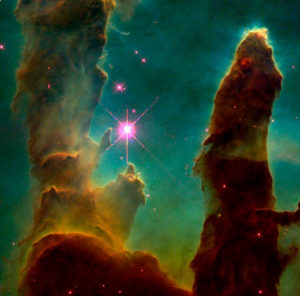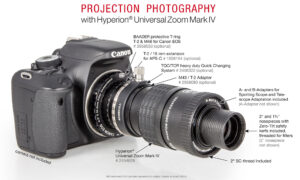FAQ
-
StarAid Revolution FAQs on www.staraid.ai
This entry was posted on March 8, 2021 Last modified on February 28, 2024.
Please visit the website https://staraid.ai/support/faq/ for many questions and answers about the StarAid Revolution.
-
HALOS – viewed without prejudice
This entry was posted on December 19, 2019 Last modified on February 26, 2024.
The moment you insert any type of filter into the optical setup, which consists of your specific camera, the appropriate flattener/reducer or coma corrector and the telescope, the filter becomes part of this unique optical system. And every optical system is different because many products from different manufacturers are involved. All optical surfaces interact with each other in some way. One possibility is that coatings of the camera reflect unwanted light back into the telescope and onto all optical elements in front of the filter. If there is no other optical surface that will reflect the light back to the filter a second time, then it is perfect. There are no halos other than residual halos or scattering, which are unavoidable, depending on the filter...
-
Eyepiece Projection - How good can it get?
This entry was posted on August 13, 2019 Last modified on February 26, 2024.
Question: With eyepiece projection, the image at the edge is extremely blurred. What could be the reason for this? For eyepiece projection with our Morpheus and Hyperion (zoom) eyepieces, we recommend a distance between eyepiece and T-ring of 40 mm on full-frame cameras, in addition to the 55 mm that were the flange focal distance of all "SLR" and DSLR camera bodies for decades when a T-ring was placed in front. Only with a T-ring that maintains this distance can old lenses with a T-thread deliver sharp images. Therefore, it has been tried to take this distance into account in all designs, because this is the only way to ensure that the sharpness performance is optimal. Of course, all this is only valid to a...
-
Manual Zeroing is not working, even though I followed the manual step by step. What am I doing wrong?
This entry was posted on May 6, 2019 Last modified on February 28, 2024.
Thanks for bringing this to our attention! On page 8 of the SD II Controller manual we have indeed noted an error. With variant 2 (manual homing), steps 1+2 must first be carried out as in variant 1, not steps 1-3 as incorrectly indicated. We apologize for the inconvenience. The corrected manual can be downloaded here.
-
Can I use the SteelGo II Software also with Windows 7?
This entry was posted on May 6, 2019 Last modified on February 28, 2024.
To successfully connect the SteelDrive II Controller with the SteelGo II Software using Windows 7, current virtual COM-port drivers need to be installed. Download: https://www.ftdichip.com/Drivers/CDM/CDM21228_Setup.zip
-
My spectra show dark stripes (see mark in picture) - where do they come from?
This entry was posted on November 14, 2017
Dark horizontal streaks or stripes in the spectrum are caused by dust deposits on the slit plate of the spectrograph. A partial attenuation of the spectrum results from dust spots (“Donuts”) on the camera sensor. Let's start with the slit plate of the spectrograph. A dust grain deposited on the slit becomes apparent across the spectrum as a horizontal, dark line perpendicular to the spectral lines. The more frequently the DADOS is attached to the telescope, the more dust can penetrate. And dust can also penetrate through the 1 1/4 " nosepiece of the slit viewer when changing the guide camera. Cleaning is critical and not recommended because wiping on the slit plate would cause serious harm. Gently blow away dust from the slit plate...
-
Off-standard single filter sizes from Baader - why not:
This entry was posted on July 12, 2017 Last modified on February 27, 2024.
Quite often we receive requests for a single filter in an off-standard size. In all cases we are sorry that we must answer as follows: Sorry (we know it would be so very much cheaper in production - and we would be so much more flexible to fill special requests) - but we have decided long ago to not cut or saw our filters from large plates because this would leave the coating stack open and mutilated (with microscopic cracks) all around, prone to aging and peeling. Many times we had the chance to inspect our competitors filters after several years of use (due to our 30+years of servicing SBIG-CCD-cameras/and filter wheels) and we realized already 15 years ago how moisture and heat stress can...
-
Unmounted Filters – which side should face the telescope?
This entry was posted on July 4, 2016 Last modified on February 28, 2024.
For our CMOS-optimized filters we have created the following images showing which side of the filter should face the telescope. LEGACY FAQ for older unmounted CCD-Filters without black outer rim Question in Detail: I just bought LRGB 36mm unmounted filters. I have question: which side of filter should be placed towards telescope? Is it better way of distinguish than "more shiny surface towards telescope"? Answer: Always put the more reflective side towards the telescope side. To guide you we already put a small arrow on the filter rim, on those filters were the position matters. This arrow indicates which face of the filter should be directed towards the sky (telescope-sided). All cell-mounted filters are already oriented in a way that the most appropriate filter face...
-
Solar FAQ on www.astrosolar.com
This entry was posted on July 4, 2016 Last modified on February 28, 2024.
Please visit our website www.astrosolar.com/en/faqs for many questions and answers on our solar products, such as AstroSolar Film, Solar Viewers and mounted Baader Solar Filters.
-
ClickLock clamp is spinning where it shouldn't
This entry was posted on July 4, 2016 Last modified on February 28, 2024.
Question in Detail: I just received a Baader 2" Clicklock TAK-adapter M72. After a few uses it's spinning where it shouldn't. If I hold the inside on the bottom near where it threads onto the scope it works. Can you tell me what to do? Can I repair it? Answer: This might be a mistake done here during assembly. Please try this fix. If it does not help please return the Clicklock clamp to us or to your dealer, we apologizie. Actually the 2"/M72 ClickLock is consisting of the M68 ClickLock and the Adapter M68/M72. There are 6x M2.5 screws underneath the M68/M72 Adapter. These prevent the M68 thread from rotating. It seems that they where not properly tightened. If you grab the very small...




